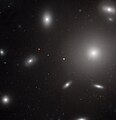Файл:NGC 4874 HST.jpg

Барам хьажале: 578 × 600 пиксель. Кхин шоралла: 231 × 240 пиксель | 463 × 480 пиксель | 740 × 768 пиксель | 987 × 1024 пиксель | 1973 × 2048 пиксель | 3864 × 4010 пиксель.
Оригиналан файл (3864 × 4010 пиксель, файлан барам: 5,95 Мб, MIME-тайп: image/jpeg)
Файлан истори
Тlетаlаде терахь/хан, муха хилла хьажарна и файл.
| Терахь/Хан | Жима | Файлан барам | Декъашхо | Билгалдаккхар | |
|---|---|---|---|---|---|
| карара | 2011, 20 сентябрь, 11:55 |  | 3864 × 4010 (5,95 Мб) | Jmencisom |
Файл лелор
ХӀара файл лахарчу 1 агӀонгахь лелош йу:
Глобалан файл лелор
ХӀара файл лелош йу лахахь гайтина йолу википедеш чохь:
- Лелор ar.wikipedia.org
- Лелор arz.wikipedia.org
- Лелор ast.wikipedia.org
- Лелор az.wikipedia.org
- Лелор be.wikipedia.org
- Лелор cs.wikipedia.org
- Лелор de.wikipedia.org
- Лелор diq.wikipedia.org
- Лелор en.wikipedia.org
- Лелор et.wikipedia.org
- Лелор eu.wikipedia.org
- Лелор fr.wikipedia.org
- Лелор hr.wikipedia.org
- Лелор it.wikipedia.org
- Лелор ja.wikipedia.org
- Лелор kk.wikipedia.org
- Лелор ko.wikipedia.org
- Лелор mk.wikipedia.org
- Лелор nl.wikipedia.org
- Лелор pl.wikipedia.org
- Лелор ru.wikipedia.org
- Лелор sk.wikipedia.org
- Лелор sl.wikipedia.org
- Лелор tt.wikipedia.org
- Лелор uk.wikipedia.org
- Лелор uz.wikipedia.org
- Лелор www.wikidata.org
- Лелор zh.wikipedia.org